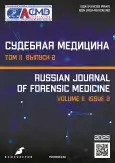Selecting thermometer accuracy in estimating the postmortem interval using body temperature-based methods: A technical report
- Authors: Vavilov A.Y.1, Khalikov A.A.2, Naidenova T.V.2
-
Affiliations:
- Bashkir State Medical University
- Izhevsk State Medical Academy
- Issue: Vol 11, No 2 (2025)
- Pages: 137-144
- Section: Technical reports
- URL: https://bakhtiniada.ru/2411-8729/article/view/313914
- DOI: https://doi.org/10.17816/fm16250
- EDN: https://elibrary.ru/CQYNFL
- ID: 313914
Cite item
Full Text
Abstract
BACKGROUND: Establishing the postmortem interval of a deceased individual with the highest possible accuracy is critical for the objective investigation of criminal homicide. It is well known that instrumental error in measuring a parameter used in calculations is one of the primary sources of error in any computational method. However, in body temperature-based methods for estimating postmortem interval, the accuracy of temperature measurement adequate for forensic medicine has not been established.
AIM: The work aimed to develop practical recommendations for selecting a measuring instrument for postmortem examination based on the impact of body temperature measurement accuracy and environmental factors on the error in calculated postmortem interval.
METHODS: Using the phenomenological mathematical model by Henssge et al., changes in postmortem body temperature were predicted in various diagnostic zones (brain, liver, rectum) at ambient temperatures of 0 °C and 20 °C. The method’s instrumental error was calculated for these conditions using thermometers with accuracies of 1 °C, 0.1 °C, and 0.01 °C. The results were expressed as both absolute and relative errors (%), which were calculated as the ratio of error to the postmortem interval at which it was obtained.
RESULTS: The highest relative errors were reported during the early phase of postmortem cooling and during the stage of temperature equalization between the body and the environment. In all cases, using thermometers with an accuracy of 1 °C resulted in a relative error of more than 15% of the postmortem interval value. Moreover, the use of thermometers with an accuracy of 0.1 °C or 0.01 °C ensured a relative instrumental error of no more than 5% throughout the modeling period (2–24 hours).
CONCLUSION: According to biomedical research guidelines, satisfactory results can only be achieved when body and ambient temperatures are measured with an accuracy of 0.1 °C or 0.01 °C. For practical convenience, we implemented the algorithm for calculating the instrumental error in postmortem interval estimation in the form of a Microsoft Excel spreadsheet.
Full Text
##article.viewOnOriginalSite##About the authors
Alexey Yu. Vavilov
Bashkir State Medical University
Email: izhsudmed@hotmail.com
ORCID iD: 0000-0002-9472-7264
SPIN-code: 3275-3730
MD, Dr. Sci. (Medicine), Professor
Russian Federation, UfaAirat A. Khalikov
Izhevsk State Medical Academy
Author for correspondence.
Email: airat.expert@mail.ru
ORCID iD: 0000-0003-1045-5677
SPIN-code: 1895-7300
MD, Dr. Sci. (Medicine), Professor
Russian Federation, IzhevskTatiana V. Naidenova
Izhevsk State Medical Academy
Email: abhasvar@mail.ru
ORCID iD: 0000-0001-7847-4706
SPIN-code: 7697-5731
MD, Cand. Sci. (Medicine)
Russian Federation, IzhevksReferences
- Viter VI, Vavilov AYu, Babushkina KA. The work procedure of a doctor-forensic expert when examining a corpse at the place of its discovery: a training manual. Izhevsk: Izhevsk State Medical Academy; 2016. Available from: https://www.forens-med.ru/book.php?id=4580 (In Russ).
- Novikov PI, Shved EF, Natsentov EO, et al. Modeling of processes in forensic medical diagnostics of the prescription of death. Chelyabinsk, Izhevs: Ural State Medical Academy of Continuing Education; 2008. (In Russ.) ISBN: 978-5-91385-041-6 EDN: XSFSVT
- Novikov PI. Determination of the Optimal Zone for Measuring the Body Temperature of a Corpse to Establish the Duration of Death. Forensic Medical Expertise. 1986;29(1):11–14. (In Russ.)
- Henssge C, Madea B. Estimation of the Time Since Death. Forensic Sci Int. 2007;165(2-3):182–184. doi: 10.1016/j.forsciint.2006.05.017
- Kulikov VA, Vavilov AYu. Software and hardware implementation of a thermometric method for diagnosing how long ago a person died (for forensic and forensic practice). In: Proceedings of the International Scientific and Practical Conference “Current issues of law and law enforcement at the present stage”. Krasnodar: Izdat. dom – Jug; 2013. P. 235–240. Available from: https://lawlibrary.ru/article2315301.html?ysclid=mda3tg6guz118933101 (In Russ.)
- Shved EF, Novikov PI, Vlasov AYu. Implementation on a Microcomputer of an Adaptive Method for Modeling the Process of Changing the Temperature of a Corpse. Forensic Medical Expertise. 1989;32(2):4–6. (In Russ.)
- Kulikov VA, Vavilov AYu. Forensic Examiner's Device. Medicinskaja jekspertiza i pravo. 2013;(6):59–61. (In Russ.) EDN: ROQDVN
- Glanz SA. Primer of Biostatistics. Buzikashvili NE, Samoilova DV, editors. Moscow: Praktika; 1999. Available from: https://medstatistic.ru/articles/glantz.pdf (In Russ.)
- Vavilov AYu., Khalikov AA, Shchepochkin OV, et al. On the error of the Thermometric Method for Determining the Age of Death. Problemy ekspertizy v meditsine. 2004;4(3):16–17. (In Russ.) EDN: MYVSSR
- Henssge C, Knight B, Krompecher Th, et al. The estimation of the time since death in the early postmortem period. 2nd edition. London: Hodder Arnold; 2002.
- Kildyushov ЕМ, Vavilov АYu, Kulikov VА. Diagnosis of Time of Death Using Thermometric Method in Early Postmortal Period (New Medical Technology). Vestnik sudebnoy meditsiny. 2012;1(1):19–23. EDN: PIVYGP
Supplementary files









